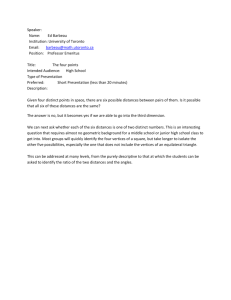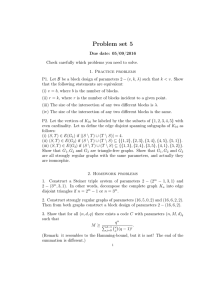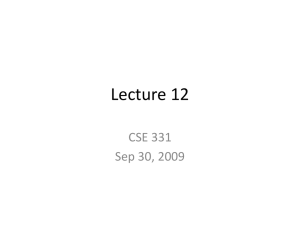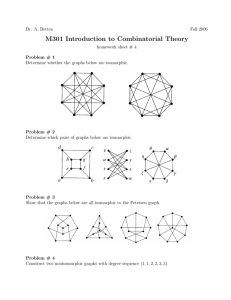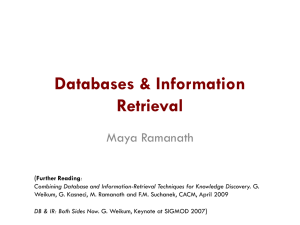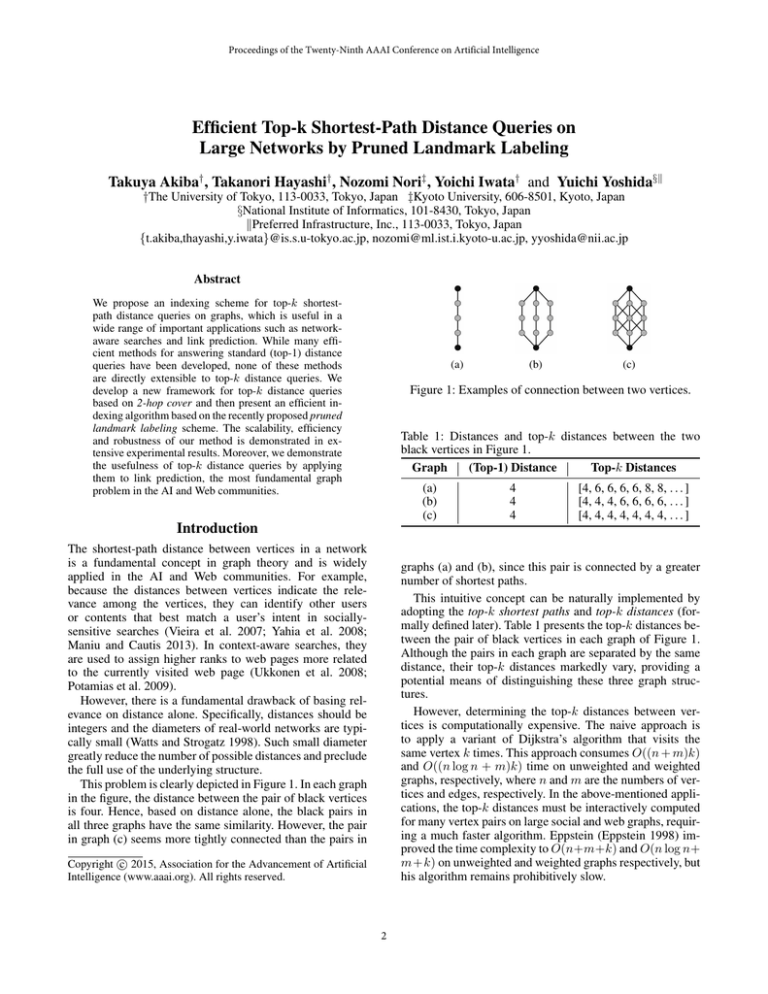
Proceedings of the Twenty-Ninth AAAI Conference on Artificial Intelligence
Efficient Top-k Shortest-Path Distance Queries on
Large Networks by Pruned Landmark Labeling
Takuya Akiba† , Takanori Hayashi† , Nozomi Nori‡ , Yoichi Iwata† and Yuichi Yoshida§k
†The University of Tokyo, 113-0033, Tokyo, Japan ‡Kyoto University, 606-8501, Kyoto, Japan
§National Institute of Informatics, 101-8430, Tokyo, Japan
kPreferred Infrastructure, Inc., 113-0033, Tokyo, Japan
{t.akiba,thayashi,y.iwata}@is.s.u-tokyo.ac.jp, nozomi@ml.ist.i.kyoto-u.ac.jp, yyoshida@nii.ac.jp
Abstract
We propose an indexing scheme for top-k shortestpath distance queries on graphs, which is useful in a
wide range of important applications such as networkaware searches and link prediction. While many efficient methods for answering standard (top-1) distance
queries have been developed, none of these methods
are directly extensible to top-k distance queries. We
develop a new framework for top-k distance queries
based on 2-hop cover and then present an efficient indexing algorithm based on the recently proposed pruned
landmark labeling scheme. The scalability, efficiency
and robustness of our method is demonstrated in extensive experimental results. Moreover, we demonstrate
the usefulness of top-k distance queries by applying
them to link prediction, the most fundamental graph
problem in the AI and Web communities.
(a)
(b)
(c)
Figure 1: Examples of connection between two vertices.
Table 1: Distances and top-k distances between the two
black vertices in Figure 1.
Graph
(Top-1) Distance
Top-k Distances
(a)
(b)
(c)
Introduction
The shortest-path distance between vertices in a network
is a fundamental concept in graph theory and is widely
applied in the AI and Web communities. For example,
because the distances between vertices indicate the relevance among the vertices, they can identify other users
or contents that best match a user’s intent in sociallysensitive searches (Vieira et al. 2007; Yahia et al. 2008;
Maniu and Cautis 2013). In context-aware searches, they
are used to assign higher ranks to web pages more related
to the currently visited web page (Ukkonen et al. 2008;
Potamias et al. 2009).
However, there is a fundamental drawback of basing relevance on distance alone. Specifically, distances should be
integers and the diameters of real-world networks are typically small (Watts and Strogatz 1998). Such small diameter
greatly reduce the number of possible distances and preclude
the full use of the underlying structure.
This problem is clearly depicted in Figure 1. In each graph
in the figure, the distance between the pair of black vertices
is four. Hence, based on distance alone, the black pairs in
all three graphs have the same similarity. However, the pair
in graph (c) seems more tightly connected than the pairs in
4
4
4
[4, 6, 6, 6, 6, 8, 8, . . . ]
[4, 4, 4, 6, 6, 6, 6, . . . ]
[4, 4, 4, 4, 4, 4, 4, . . . ]
graphs (a) and (b), since this pair is connected by a greater
number of shortest paths.
This intuitive concept can be naturally implemented by
adopting the top-k shortest paths and top-k distances (formally defined later). Table 1 presents the top-k distances between the pair of black vertices in each graph of Figure 1.
Although the pairs in each graph are separated by the same
distance, their top-k distances markedly vary, providing a
potential means of distinguishing these three graph structures.
However, determining the top-k distances between vertices is computationally expensive. The naive approach is
to apply a variant of Dijkstra’s algorithm that visits the
same vertex k times. This approach consumes O((n + m)k)
and O((n log n + m)k) time on unweighted and weighted
graphs, respectively, where n and m are the numbers of vertices and edges, respectively. In the above-mentioned applications, the top-k distances must be interactively computed
for many vertex pairs on large social and web graphs, requiring a much faster algorithm. Eppstein (Eppstein 1998) improved the time complexity to O(n+m+k) and O(n log n+
m+k) on unweighted and weighted graphs respectively, but
his algorithm remains prohibitively slow.
Copyright c 2015, Association for the Advancement of Artificial
Intelligence (www.aaai.org). All rights reserved.
2
Contribution
precluded by their high computational cost, several approximation methods have been proposed (Jeh and Widom 2003;
McSherry 2005; Sun et al. 2005; Tong, Faloutsos, and
Pan 2006). Despite sacrificing accuracy for efficiency, these
methods remain prohibitively time-expensive for computing
the RWR scores for many vertex pairs on large networks in
real-time applications, such as network-aware searches.
Similar arguments apply to other walk-based similarities
such as SimRank (Jeh and Widom 2002) and commuting
time (Lovász 1996). In contrast, as we shall experimentally
demonstrate, such large networks are efficiently handled by
our method for answering top-k distances. We also believe
that top-k distances provide features with different properties from them, which can be used as complementary features for those other vertex similarities.
Some of graph kernels (Smola and Kondor 2003), in particular, those based on the graph Laplacian such as the regularized Laplacian kernel can also be used to assign relevance
scores for vertex pairs (Ito et al. 2005). However, the computational cost of graph kernels is even more infeasible for
large graphs.
To resolve this issue, we propose an indexing method for answering the top-k distances. The proposed method is an indexing method, i.e., it first constructs a data structure called
an index from a graph and then top-k distances between arbitrary pairs of vertices are rapidly obtained using the index.
To our knowledge, we present the first indexing method to
top-k distance inquiry.
Our method is built on the recently proposed pruned landmark labeling, an indexing scheme that answers shortestpath distances (Akiba, Iwata, and Yoshida 2013). However,
modifying this method to answer top-k distances is nontrivial because the number of paths becomes crucial, bringing the new challenge of carefully avoiding double counts.
Moreover, it requires several interesting ideas in order to
keep the scalability.
As shown later in our experiments, our method can construct indices from large graphs comprising millions of vertices and tens of millions of edges within a reasonable running time. Having obtained the indices, we can compute the
top-k distances within a few microseconds, six orders of
magnitude faster than existing methods, which require a few
seconds to compute these distances.
Moreover, to illustrate the importance of the top-k distances, we apply our method to the link prediction problem (Liben-Nowell and Kleinberg 2003), a well-studied
problem in AI and Web communities. We empirically show
that the support vector machine (SVM) with the top-k distances as its feature outperforms a number of baseline methods including singular value decomposition and random
walk with restart. We emphasize that our indexing method
enables the first use of the top-k distances for such tasks.
The results also indicate the feasibility of top-k distances in
other tasks, such as network-aware searching.
Our implementation of the proposed indexing method is
publicly available from the first author’s web page. We hope
that our public code will enable further exploration of top-k
distances in various applications.
Preliminaries
The current study focus on networks that are modeled
as graphs. To simplify our discussion, we consider only
undirected and unweighted graphs first. However, as discussed later, our method is easily extendible to directed and
weighted graphs.
Let G = (V, E) be a graph with a vertex set V and an
edge set E. We denote the number of vertices |V | and the
number of edges |E| by n and m, respectively. We assume
that vertices are uniquely represented by integers, enabling
natural comparisons of two vertices u, v 2 V by expressions
such as u < v or u v.
An internal vertex of a path refers to a vertex in the path
that is not an endpoint of it. Let P be a set of paths. The i-th
shortest path in P refers to the i-th path in P , ordered by
length, where ties are broken arbitrarily.
For a pair of vertices (s, t), let Pst be the set of all (unnecessarily simple) paths between s and t. For a vertex v, let
>v
be the set of paths in Pst whose internal vertices are all
Pst
6>v
be the set of paths in Pst
larger than v. Similarly, let Pst
such that at least one internal vertex is smaller than or equal
to v. Then for two vertices s and t, the i-th shortest path between s and t is the i-th shortest path in Pst . Let di-th (s, t),
6>v
d>v
i-th (s, t), and di-th (s, t) denote the length of the i-th short6>v
>v
, and Pst
, respectively. If the size of
est path in Pst , Pst
the corresponding set is less than i, then we set them to 1.
We define di-thv (s, t) and d6i-thv (s, t) similarly.
Related Work
Distance Indices. Although numerous indexing methods for computing shortest-path distances have been proposed (Cheng and Yu 2009; Xiao et al. 2009; Wei 2010;
Akiba, Sommer, and Kawarabayashi 2012; Jin et al. 2012;
Fu et al. 2013; Akiba, Iwata, and Yoshida 2013), none of
these methods can directly answer top-k distance queries.
Pruned Labeling Algorithms. Pruned labeling was first
proposed for distance queries on complex networks (Akiba, Iwata, and Yoshida 2013). Then, specialization and extensions have been proposed for reachability queries on directed acyclic graphs (Yano et al. 2013), distance queries on
road networks (Akiba et al. 2014), and distance queries on
dynamic graphs (Akiba, Iwata, and Yoshida 2014).
Problem Definition
In this paper, we propose an indexing method that, given
a graph G and a positive integer k, construct an index to
quickly answer the following query.
Other Vertex Similarities. The performance of applications related to graph mining can also be enhanced by features other than top-k distances, such as random walk with
restart (RWR). As straightforward iterative algorithms are
Problem 1 (Top-k Distance Query).
Given: A pair of vertices (s, t).
Answer: An array (d1st (s, t), d2nd (s, t), . . . , dk-th (s, t)).
3
Proposed Method
Algorithm 1 Indexing Algorithm
1: procedure C ONSTRUCT I NDEX(G)
2:
for i = 1 to n do Compute C(vi ) using the modified BFS.
3:
L(v)
; for all v 2 V .
4:
for i = 1 to n do P RUNED BFS(G, vi ).
5:
return (C, L).
This section describes our proposed method and show its
correctness. We also suggest several important techniques
for practical performance enhancement.
Data Structure
The data structure and query algorithm of the proposed
method are based on the general framework of 2-hop
cover (Cohen et al. 2002), which is designed for standard (top-1) distance queries. However, as normal distance
queries do not consider the number of paths, the main challenge in processing top-k distance queries is preventing multiple counts of the same path. To this end, we require a more
involved framework.
For each vertex v, our method precomputes and stores the
following two labels:
• Distance label L(v), comprising a set of pairs (u, ) of
a vertex and a path length. If we gather lengths in L(v)
associated with a vertex u, they should form the sequence
>v
>v
(d>v
1st (v, u), d2nd (v, u), . . . , d`-th (v, u)) for some 1 `
k.
• Loop label C(v), constituting a sequence of k integers ( 1 , 2 , . . . , k ). This sequence should equal
v
(d1stv (v, v), d2ndv (v, v), . . . , dk-th
(v, v)).
An index is a pair I = (L, C), where L and C are the sets
of distance labels {L(v)}v2V and loop labels {C(v)}v2V ,
respectively.
Algorithm 2 Pruned Top-k BFS from v 2 V .
1: procedure P RUNED BFS(G, v)
2:
Q
a queue with only one element (v, 0).
3:
while Q is not empty do
4:
Dequeue (u, ) from Q.
5:
if < max (Q UERY((L, C), v, u)) then
6:
Add (v, ) to L(u).
7:
for all w 2 V such that (u, w) 2 E, w > v do
8:
Enqueue (w, + 1) onto Q.
The modified BFS returns to the starting vertex long before all vertices in the graph have been visited. Consequently, the running time is very small in practice and empirically estimated as O(nk) in total from experiments.
Algorithm for Computing Distance Labels. We assume
that vertices in V are ordered as v1 , v2 , . . . , vn . Then for
each 1 i n, we perform a pruned BFS from vi (Algorithm 2). The pruned BFS is essentially a modified version of the BFS from v that visits the same vertex at most
k times. The crucial difference is the non-trivial pruning;
that is, when visiting a vertex u at distance , the process is
discontinued if is larger than or equal to the k-th shortest
distance computable by the current index (L, C) (Line 5).
We roughly estimate the time complexity. Let l be the average size of labels. We visit O(nl) vertices in total, traversing O( m
n ) edges on average and evaluating a query in O(l)
time (by using the fast pruning technique introduced later).
Thus, the total time complexity of this part is O(ml + nl2 ).
In our experiments, l was a few hundred.
Query Algorithm
Given an index I = (L, C) and a pair of vertices (s, t),
we compute the top-k distances between s and t as follows.
First, we compute the following multiset.
(I, s, t) = {
+ vv + vt | (v, sv ) 2 L(s),
vv 2 C(v), (v, vt ) 2 L(t)}.
sv
Intuitively, we first move from s to v, then loop back to v
several steps later, and finally move from v to t. Note that
from the definition of distance labels and loop labels, every
internal vertex in the path from s to t (except v itself) is
larger than v.
Let Q UERY(I, s, t) denote the smallest k elements in the
multiset (I, s, t). If | (I, s, t)| < k, the remaining entries are filled with 1. Our answer to the query (s, t) is
Q UERY(I, s, t).
Proof of Correctness
The correctness of our method is shown as follows. Let Li
denote the set of distance labels L after the i-th pruned BFS
from vi . We define L0 (v) = ; for any v. Let Ii denote pair
(Li , C) of the partially constructed set of distance labels and
the set of loop labels. We prove the following lemma.
Lemma 1. For every integer i where 0 i n,
and every pair of vertices (s, t), Q UERY(Ii , s, t) =
vi
6>vi
6>vi
(d6>
1st (s, t), d2nd (s, t), . . . , dk-th (s, t)) holds.
Indexing Algorithm
Our index constructing algorithm is summarized in Algorithm 1. We first compute the loop label C(v) for every vertex v. We then construct the distance labels L by conducting
a pruned BFS from each vertex.
Proof. We prove the claim by induction on i. When i = 0,
we have Q UERY(Ii , s, t) = (1, 1, . . . , 1) and the claim
clearly holds. Suppose that the claim holds for every i0 < i.
For a fixed pair of vertices (s, t) where s 6= t, we validate
the claim for i and the pair (s, t).
Note that we can already compute Q UERY(Ii 1 , s, t) =
6>v
6>v
6>v
(d1sti 1 (s, t), d2ndi 1 (s, t), . . . , dk-thi 1 (s, t)). Let P denote
>v
the set of paths P such that (i) P is in Pst i 1 , (ii) P
passes through vi , and (iii) the length of P is smaller than
Algorithm for Computing Loop Labels. We construct
the loop labels as follows. For each vertex v, using vertices
larger than or equal to v, we perform a modified version of
breadth first search (BFS). In the BFS, each vertex may be
visited up to k times. The first k visits to the vertex v gives
v
(v, v).
the distance sequence d1stv (v, v), d2ndv (v, v), . . . , dk-th
4
6>v
and significantly reduces the number of pushes onto the
queue. Hence, it significantly reduces the running time.
dk-thi 1 (s, t). Let P 0 be the first k elements in P. It suffices
to show that, after the i-th pruned BFS, we can also compute
the distances of paths in P 0 .
Let P 2 P 0 . We can split P into three parts Psvi , Pvi vi ,
and Pvi t . Here, Psvi denotes the subsequence of P from s
to the first appearance of vi in P , Pvi vi denotes the subsequence of P from the first appearance of vi to the final appearance of vi in P , and Pvi t denotes the subsequence of P
from the last appearance of vi in P to t. Note that Pvi vi must
i
; otherwise shorter k
be among the first k elements in Pv>v
i vi
paths are possible and P 2 P 0 is contradicted. Hence, C(vi )
must include the length of Pvi vi .
Now we observe that the BFS from vi along path Pvi t is
not pruned in the i-th pruned BFS (and similarly for Psvi ).
To illustrate by contradiction, suppose that the BFS is pruned
at some vertex u on path Pvi t . In this case, there exist at
6>v
least k paths in Pvi ui 1 shorter than , where is the distance from vi to u in the BFS. For each of these k paths, we
concatenate Psvi , Pvi vi , and the suffix of Pvi t from u to t.
6>v
Then, we obtain k paths in Pst i 1 that are shorter than P ,
6>vi 1
and therefore shorter than dk-th (s, t) from condition (iii).
Hence, we reach a contradiction.
Merged Label Entries. Related to the above technique,
instead of pairs (u, ), which denotes that there is a path
of length between v and u, triplets (u, , c) are stored in
distance labels. These triplets indicate that c paths of length
exist between v and u. A similar technique is applicable to
loop labels.
Extensions
Directed graphs. If the input graph is a directed graph, we
compute and store two distance labels LIN (v) and LOUT (v)
for each vertex v, where LIN (v) and LOUT (v) contain the
distances from and to v, respectively.
Weighted graphs. For weighted graphs, we can replace
the pruned BFS by pruned Dijkstra’s algorithm. In this
scheme, the queue used in Algorithm 2 is replaced by
a priority queue. The time complexity becomes O(ml +
nl(log n + l)).
Experimental Evaluation
Corollary 1. At the end of Algorithm 1, we can correctly
answer top-k distance queries using the constructed index.
In this section, we show the scalability, efficiency and robustness of the proposed method by experimental results using real-world networks.
Techniques for Efficient Implementation
Setup
We introduce several key techniques for practical performance improvement.
Environment. All experiments were conducted on a
Linux server with Intel Xeon X5670 (2.93 GHz) and 48 GB
of main memory. The proposed method was implemented in
C++. The implementation will be made publicly available
online.
Vertex Ordering Strategy. By properly selecting the order of vertices from which we conduct pruned BFSs, our
pruning can drastically reduce the search space and label
sizes by exploiting the structure of real-world networks,
greatly enhancing the efficiency of the proposed method.
This is possible because the real networks contain highly
centralized vertices (sometimes called hubs). As a heuristic
vertex ordering strategy, vertices are selected in order of decreasing degrees. Further discussion is provided in (Akiba,
Iwata, and Yoshida 2013).
Datasets. The target applications of the proposed method
are graph mining tasks such as network-aware searching and
link prediction. Therefore, our experiments were conducted
on publicly available real-world social and web graphs12345 .
The sizes and types of these graphs are listed in Table 2. We
treated all the graphs as unweighted undirected graphs.
Algorithms. As there are no previous indexing methods
for top-k distances, the proposed method was evaluated
against the following two algorithms without precomputation.
Fast Pruning. When constructing distance labels, many
queries are evaluated for pruning. However, when conducting a pruned BFS from a vertex v, queries are limited to “Are
there more than k paths of length less than between v and
u?” Given this restriction, we can reduce the query time. For
each vertex w in the distance label of v, we can precompute
the number cw, 0 of paths between v and w of length not exceeding 0 using the loop label C(w). Suppose that we have
reached vertex u in the pruned BFS conducted from v. We
can then compute thePnumber of paths between v and u of
length less than as (w, 0 ,c)2L(u) c · cw, 0 .
• The first is the BFS-based naive approach, which uses a
FIFO queue in the graph search, but which allows at most
k visits to each vertex. This algorithm was also implemented in C++ by the authors.
• The second is Eppstein’s algorithm (Eppstein 1998),
which theoretically attains near-optimal time complexity.
We adopted the C++ implementation of Jon Graehl6 .
Merged Queue Entries. When a (pruned) BFS is performed from a vertex v, rather than pair (u, ), which denotes the existence of a path of length between v and u,
triplets (u, , c) are pushed onto the queue. These triples
specify that c paths of length exist between v and u, This
technique enables the simultaneous handling of many paths,
1
http://lovro.lpt.fri.uni-lj.si/support.jsp
http://grouplens.org/datasets/hetrec-2011/
3
http://snap.stanford.edu/
4
http://socialnetworks.mpi-sws.org/datasets.html
5
http://law.di.unimi.it/datasets.php (Boldi and Vigna 2004)
6
http://www.ics.uci.edu/ eppstein/pubs/p-kpath.html
2
5
Table 2: Dataset information and performance of the proposed and existing methods on real-world datasets (k = 8).
Dataset
Top-k PLL (this work)
Indexing time
Index size
Query time
Name
Type
Facebook-1
Last.fm
GrQc
HepTh
CondMat
Facebook-2
YouTube-1
YouTube-2
Social
Social
Social
Social
Social
Social
Social
Social
334
1,892
5,242
9,877
23,133
63,732
1,157,828
3,238,848
2,218
12,717
14,496
25,998
186,936
1,545,686
4,945,382
18,512,606
13.7 ms
125.3 ms
152.9 ms
631.2 ms
3.2 s
239.0 s
624.3 s
1627.1 s
178.6 KB
1.3 MB
2.7 MB
7.8 MB
26.4 MB
716.8 MB
2.3 GB
9.6 GB
NotreDame
Stanford
BerkStan
Indo
Web
Web
Web
Web
325,729
281,903
685,230
1,382,906
1,497,134
2,312,497
7,600,595
16,539,644
52.3 s
42.5 s
108.7 s
2695.3 s
617.7 MB
230.0 MB
1.0 GB
6.0 GB
|V |
(a) Indexing time
|E|
(b) Index size
BFS
Eppstein
1.9 µs
1.7 µs
1.6 µs
2.2 µs
3.1 µs
15.2 µs
5.1 µs
3.9 µs
227.1 µs
1.6 ms
2.2 ms
5.5 ms
15.2 ms
117.6 ms
1.5 s
5.0 s
378.4 µs
7.5 ms
7.3 ms
16.5 ms
158.8 ms
2.7 s
7.0 s
41.1 s
2.9 µs
1.7 µs
1.9 µs
12.1 µs
249.8 ms
454.9 ms
643.3 ms
1.4 s
1.7 s
2.9 s
10.8 s
25.4 s
(c) Query time
Figure 2: Effect of k on indexing time, index size, and query time.
Indexing Time and Index Size
time was six orders of magnitude faster than those of the
BFS-based and Eppstein algorithms. In our experiments the
BFS-based method was faster than Eppstein’s algorithm.
This is due to the big constant factor hidden in the Onotation of the time complexity of Eppstein’s algorithm, as
it involves complex data structure manipulation.
Figure 2c plots the query time as a function of k. Although
the query time increased with k, it remained sufficiently fast
at high k.
The high scalability of the proposed method is evident from
the index construction time and constructed index size reported in Table 2. Indices were constructed from large social and web graphs comprising tens of millions of edges
(YouTube-2 and Indo) in one hour. The index sizes are below 10 GB, easily accommodated by the main memories of
modern commodity computers.
While the index construction of all datasets was consistently efficient, we observe that the indexing time does not
depend on graph size alone. The efficiency of the proposed
method relies on the efficiency of pruning, and is thus related to network properties such as degree distribution and
clustering coefficient. However, because the graphs of realworld social, web, computer and biological networks exhibit
similar qualitative properties, the proposed method is robust
and consistently efficient. The same argument is valid for
index size.
Figure 2a and 2b illustrate the effect of k on the indexing time and index size in the proposed method. Both are
relatively insensitive to the value of k.
Application to Link Prediction
This section demonstrates the usefulness of the proposed
method by applying it to the link prediction problem (LibenNowell and Kleinberg 2003). In particular, we confirm that
top-k distances can contribute to prediction precision improvement. Note that our indexing method enables the first
use of the top-k distances for such tasks, because top-k distances must be computed for many pairs of vertices during
training and evaluation.
We selected link prediction as it is one of the most fundamental and popular problems on graphs in the AI and Web
communities. However, the results suggest the applicability of top-k distances to other graph tasks such as networkaware searching.
Query Time
The proposed method generally answers queries within microseconds, very much faster than the other algorithms (Table 2). Indeed for the largest dataset, YouTube-2, the query
6
Table 3: Predictive performance (AUC) of the method based on top-k distances and several baseline methods on the link
prediction problem. Statistically significant winners (by paired t-test with p < 0.05) are highlighted in bold font.
Dataset
Facebook-1
Facebook-2
Last.fm
GrQc
HepTh
CondMat
CN
Jaccard
Adamic
Preferential
Combined
SVD
RWR
Top-k
Top-1
0.806
0.776
0.596
0.658
0.546
0.763
0.812
0.777
0.597
0.658
0.546
0.763
0.817
0.777
0.603
0.658
0.547
0.764
0.754
0.875
0.831
0.709
0.686
0.749
0.890
0.755
0.861
0.793
0.714
0.877
0.792
0.823
0.644
0.791
0.774
0.875
0.873
0.949
0.844
0.802
0.779
0.900
0.901
0.931
0.876
0.824
0.817
0.929
0.808
0.931
0.802
0.799
0.775
0.896
Setup
Prediction Settings. We randomly sampled 60% edges
for training and reserved the remaining 40% for evaluation.
The task was to predict the hidden evaluation edges given
training edges. The sampling, prediction and evaluation procedures were performed 10 times on each datasets.
As an evaluation metric for predictive performance, we
used AUC (area under the ROC curve). Generally, AUC is
defined as the probability of predictions for positive examples larger than those for negative ones in test set. Since the
tested datasets contain only positive, our investigation constitutes a “positive-and-unlabeled” case. Therefore, in our
AUC evaluation, our test set is regarded as a subset of positive links. Withholding these links, we applied the evaluated methods to the dataset, treating the withheld links as
no-links. We evaluated AUC as the probability that a randomly sampled withheld link has a higher predicted relational strength than a randomly sampled no-link vertex pair.
Figure 3: Effect of k on AUC, evaluated on the Last.fm
dataset
to the above method with k = 1; its purpose was to evaluate
the true importance of the top-k (k > 1) distances.
Datasets. We used the six smaller social networks extracted from the graphs in the previous section, as some of
the baseline methods (such as RWR) were too computationally expensive.
Method Based on Top-k Distances. We used the top-k
distances as features in a support vector machine (SVM).
More precisely, assuming ( 1 , 2 , . . . , k ) as the top-k distances of a vertex pair, we defined the features
p of the pair as
k values, where the i-th value is given by 1/ i . The value
of k was tuned among {20 , 21 , . . . , 26 }, using one sample as
a development dataset. Moreover, for each dataset we tested
both linear SVM and non-linear SVM (with the RBF kernel) and selected the better performing one using the development dataset. The results on the development dataset are
not included in the actual evaluation.
Results
Predictive Performance. Table 3 shows the mean AUCs
for each method and dataset. The top-k distance method outperformed all the other methods for almost all the datasets.
The exception was Facebook-2, for which the method based
on top-k distances performed comparably to the top performer, RWR. Moreover, in most of the datasets, the top-k
distances yielded higher performance than the top-1 (usual)
distance.
Baseline Methods. As baseline methods, we selected four
methods commonly used in link prediction; (1) CN (Common neighbors), (2) Jaccard, (3) Adamic, (4) Preferential
(Preferential Attachment). The scores of these methods were
used as link scores. We also considered (5) a Combined
method, in which the link scores of the four baseline methods were used as the features in SVM. We further compared our method with (6) SVD (singular value decomposition) (Golub and Loan 1996) and (7) RWR (Random Walk
with Restart), and (8) Top-1 distance. In SVD, the link score
is calculated by cosine similarity based on the latent vectors.
The number of latent dimension in SVD was tuned among
{20 , 21 , . . . , 28 }, again using one sample as a development
dataset. We adopted the RWR parameters of (He et al. 2004;
Tong, Faloutsos, and Pan 2006). More specifically, the
restart probability was set to 0.95 and the number of iterations was set to 50. The top-1 distance method corresponds
Parameter Sensitivity. We experimentally studied the
effect of the parameter k. Figure 3 plots the AUCs
of the proposed method for the Last.fm dataset with k
{20 , 21 , . . . , 26 }. We observe that the predictive performance was stable with respect to k.
Conclusion
In this study, we proposed a new indexing method that
quickly answers top-k distance queries on large networks.
Indeed, we present the first practical indexing method for
top-k distances. The efficiency, scalability and robustness
of the method was evaluated in extensive experiments on
real-world social and web graphs. Moreover, by applying the
method to link prediction, we indicated the practicability of
top-k distance queries to various applications.
7
Acknowledgments
Maniu, S., and Cautis, B. 2013. Network-aware search in
social tagging applications: Instance optimality versus efficiency. In CIKM, 939–948.
McSherry, F. 2005. A uniform approach to accelerated
pagerank computation. In WWW, 575–582.
Potamias, M.; Bonchi, F.; Castillo, C.; and Gionis, A. 2009.
Fast shortest path distance estimation in large networks. In
CIKM, 867–876.
Smola, A. J., and Kondor. 2003. Kernels and regularization
on graphs. In COLT, 144–158.
Sun, J.; Qu, H.; Chakrabarti, D.; and Faloutsos, C. 2005.
Neighborhood formation and anomaly detection in bipartite
graphs. In ICDM, 418–425.
Tong, H.; Faloutsos, C.; and Pan, J.-Y. 2006. Fast random
walk with restart and its applications. In ICDM, 613–622.
Ukkonen, A.; Castillo, C.; Donato, D.; and Gionis, A. 2008.
Searching the wikipedia with contextual information. In
CIKM, 1351–1352.
Vieira, M. V.; Fonseca, B. M.; Damazio, R.; Golgher, P. B.;
Reis, D. d. C.; and Ribeiro-Neto, B. 2007. Efficient search
ranking in social networks. In CIKM, 563–572.
Watts, D. J., and Strogatz, S. H. 1998. Collective dynamics
of ‘small-world’ networks. Nature 393(6684):440–442.
Wei, F. 2010. Tedi: efficient shortest path query answering
on graphs. In SIGMOD, 99–110.
Xiao, Y.; Wu, W.; Pei, J.; Wang, W.; and He, Z. 2009. Efficiently indexing shortest paths by exploiting symmetry in
graphs. In EDBT, 493–504.
Yahia, S. A.; Benedikt, M.; Lakshmanan, L. V. S.; and Stoyanovich, J. 2008. Efficient network aware search in collaborative tagging sites. PVLDB 1(1):710–721.
Yano, Y.; Akiba, T.; Iwata, Y.; and Yoshida, Y. 2013. Fast
and scalable reachability queries on graphs by pruned labeling with landmarks and paths. In CIKM, 1601–1606.
Takuya Akiba, Nozomi Nori and Yoichi Iwata are supported
by Grant-in-Aid for JSPS Fellows (256563, 269329 and
256487, respectively). Takanori Hayashi and Yuichi Yoshida
are supported by JST, ERATO, Kawarabayashi Large Graph
Project. Yuichi Yoshida is supported by JSPS Grant-in-Aid
for Young Scientists (B) (No. 26730009) and MEXT Grantin-Aid for Scientific Research on Innovative Areas (No.
24106003).
References
Akiba, T.; Iwata, Y.; Kawarabayashi, K.; and Kawata, Y.
2014. Fast shortest-path distance queries on road networks
by pruned highway labeling. In ALENEX, 147–154.
Akiba, T.; Iwata, Y.; and Yoshida, Y. 2013. Fast exact
shortest-path distance queries on large networks by pruned
landmark labeling. In SIGMOD, 349–360.
Akiba, T.; Iwata, Y.; and Yoshida, Y. 2014. Dynamic and
historical shortest-path distance queries on large evolving
networks by pruned landmark labeling. In WWW, 237–248.
Akiba, T.; Sommer, C.; and Kawarabayashi, K. 2012.
Shortest-path queries for complex networks: exploiting low
tree-width outside the core. In EDBT, 144–155.
Boldi, P., and Vigna, S. 2004. The webgraph framework I:
compression techniques. In WWW, 595–602.
Cheng, J., and Yu, J. X. 2009. On-line exact shortest distance
query processing. In EDBT, 481–492.
Cohen, E.; Halperin, E.; Kaplan, H.; and Zwick, U. 2002.
Reachability and distance queries via 2-hop labels. In
SODA, 937–946.
Eppstein, D. 1998. Finding the k shortest paths. SIAM J.
Computing 28(2):652–673.
Fu, A. W.-C.; Wu, H.; Cheng, J.; Chu, S.; and Wong, R. C.W. 2013. Is-label: an independent-set based labeling scheme
for point-to-point distance querying on large graphs. PVLDB
6(6):457–468.
Golub, G. ., and Loan, C. . 1996. Matrix Computations.
Johns Hopkins Studies in the Mathematical Sciences.
He, J.; Li, M.; jiang Zhang, H.; Tong, H.; and Zhang, C.
2004. Manifold-ranking based image retrieval. In MM, 9–
16.
Ito, T.; Shimbo, M.; Kudo, T.; and Matsumoto, Y. 2005.
Application of kernels to link analysis. In KDD, 586–592.
Jeh, G., and Widom, J. 2002. Simrank: a measure of
structural-context similarity. In KDD, 538–543.
Jeh, G., and Widom, J. 2003. Scaling personalized web
search. In WWW, 271–279.
Jin, R.; Ruan, N.; Xiang, Y.; and Lee, V. 2012. A highwaycentric labeling approach for answering distance queries on
large sparse graphs. In SIGMOD, 445–456.
Liben-Nowell, D., and Kleinberg, J. 2003. The link prediction problem for social networks. In CIKM, 556–559.
Lovász, L. 1996. Random walks on graphs: A survey.
In Combinatorics, Paul Erdős is Eighty, volume 2. János
Bolyai Mathematical Society. 353–398.
8


